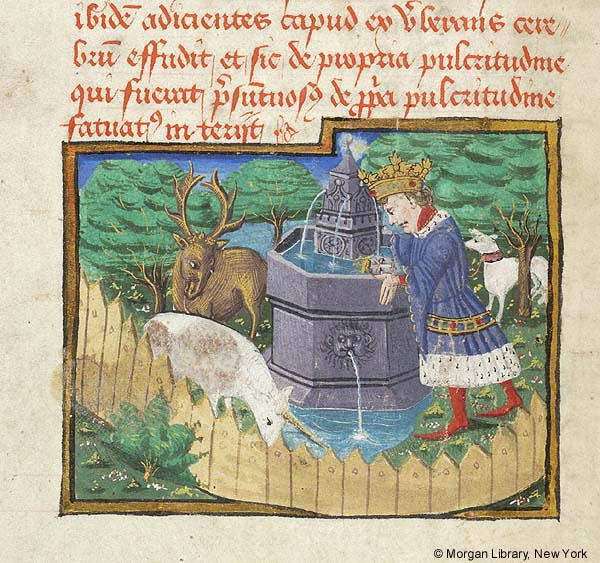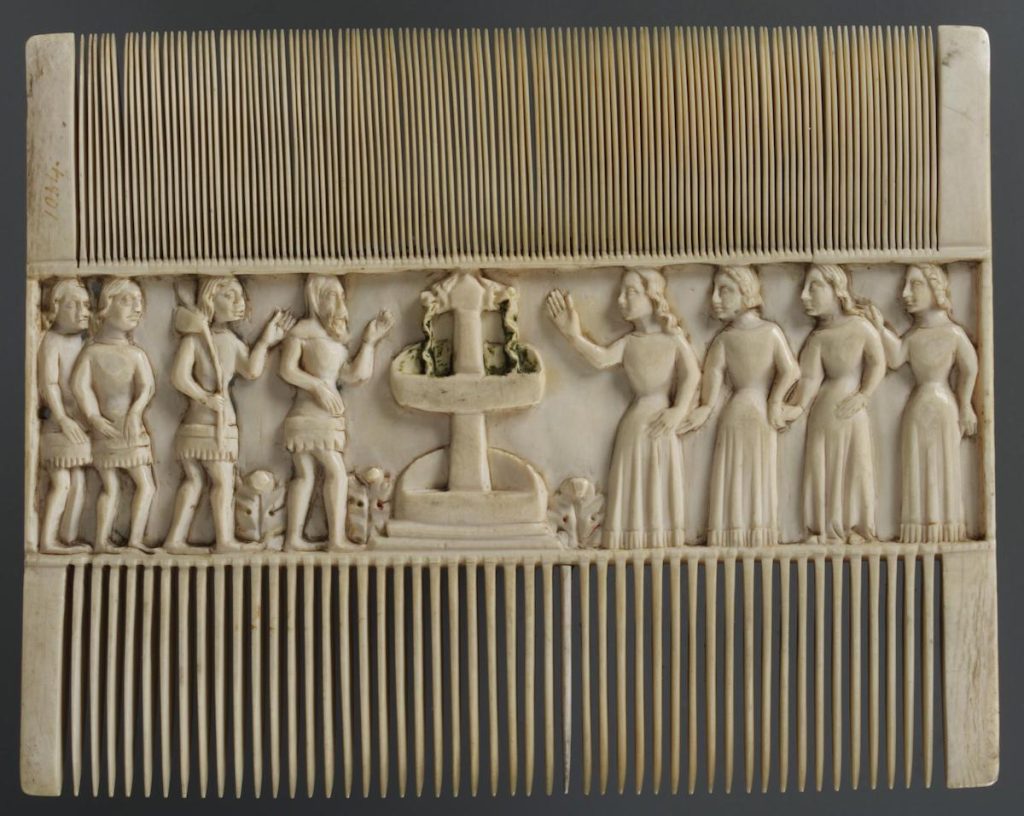

It’s May again, the month that marked the traditional beginning of summer in the Middle Ages. Much as it still is today, this seasonal turn was celebrated with festivals that set aside the toil of spring in favor of games and leisure. In medieval iconography, this time of the year is also captured in a variety of courtship scenes belonging to a genre known as “courtly love.” Such scenes sometimes represented the month of May with depictions of couples playing a game of chess or setting out on horseback for the sport of falconry and hunting, as well as holding merry engagements around fountains or flowing springs. The typical zodiac sign associated with the month of May was Gemini, usually represented by a pair of either twins or lovers, which epitomized the idea of two for this time of year: a double, a match, and a mirror image.
The iconography of mirror and fountains is similar in its ability to emanate personal reflections of a viewer, which made them desirable themes to utilize in courtly imagery. While the idea of gazing at your “twin,” perhaps framed in a window or seated across a chessboard, was celebrated in the Middle Ages, looking at your own reflection for too long, or for the wrong reasons, was frowned upon. A classic warning appears in the tale adapted from Ovid’s Metamorphoses of the mythological Greek hunter Narcissus, who so loved his own reflection that he became fixated on it for life, rejecting all offers of love.

The Narcissus theme is represented in a late fifteenth century miniature in an English manuscript of the Confessio Amantis (“Confessions of a Lover”) by John Gower (d. 1408). The artist depicts a kingly Narcissus wearing a crown, a vair-lined garment, and a jeweled girdle while staring at his own reflection in a fountain (Fig. 1). Narcissus stands in a fenced enclosure surrounded by a unicorn, a collared dog, and a stag. The presence of the stag evokes an Aesopian fable with a similar message, usually called the “Stag and its Reflection” (or the “Proud Stag”), in which a stag admires his antlers in a pool for too long and is caught by the hunter. Like its captive animal companions, the stag echoes Narcissus’s enmeshment in his self-image and ties him to the fountain.
In the popular medieval romance known as the Roman de la Rose, by Guillaume de Lorris (fl. ca. 1230), the “Lover” (Amans) encounters the Fountain of Narcissus and is similarly drawn to look at the reflection of his face in the water (Fig. 2). Like Narcissus, the Lover in the Roman de la Rose is taken with his own beauty in the pool and leans over to admire it; but unlike that of Narcissus, the pool is also the “Fountain of Love,” which destined all who looked in to fall in love. Thus, the Lover’s self-reflection is deeper and more altruistic than his external features, allowing him to overcome the curse of vanity and experience an ideal transformation.

Among the most interesting imagery related to mirrors, fountains, and love is that on Gothic mirror cases, also called valves de miroir. Over seventy examples currently exist in the Index of Medieval Art database, and you can find them by browsing for “Mirror Case” under Work of Art Type. Such mirror cases would twist open to reveal a polished metal disk for personal reflection, while imagery on the closed case told an allegorical story linked with chivalric lore. Mirrors have been part of society since antiquity when they were first made of highly polished stones. The mirror is an essential tool in the iconography of the Toilet of Venus, and it also became both a virtuous attribute for the self-aware personification of Prudence and a sign of vice for that of Vanity. Yet the images carved on Gothic ivory mirror cases rarely warn about the dangers of selfish looking. Instead, they often present scenes of youthful love. On a mirror case in the Walters Art Museum, within the arched portcullis of a castle, a man cups the chin of a woman in a gesture called “chin-chucking” (Fig. 3).
On the Walters ivory mirror back, other young people engage in friendly activities while a group of disabled or elderly persons parade toward the waters of the allegorical “Fountain of Youth” seeking an immortalizing dip. A similar procession of four pairs of men and women meeting at a central two-tiered fountain issuing streams of water appears on a double-sided ivory comb in the Victoria & Albert Museum, made ca. 1400 (Fig. 4). Here, the couples do not gaze into the fountain, nor do they bathe in its restorative waters, but the fountain separates the groups into symmetrical pairs, suggesting an impending connection. The glossy surfaces of mirrors and fountains, with a myriad of possible reflections—of a person’s vanity or deep self-knowing, the promise and capture of love, or the hope of love as a soothing, restorative balm—made these water features the appropriate gathering places for courtly lovers.

The month of May can resemble December for those of us on the academic calendar. The buzz of the semester diminishes to a low hum; there are fewer events, fewer emails to answer, and fewer faces around campus as people take time away from university life. Some might take a break from their work to review their activities and reconnect to individual goals and missions. These yearly transitions can also be times of reflection. Wherever this summer takes you, for work or on trips to faraway lands, we wish you good health and safe travels!
Select Subjects of “Love” Interest in the Index of Medieval Art
The following iconographic headings can be accessed in the Index of Medieval Art Subject List:
Married Pair —The iconographic depiction of a husband and wife together, identified or not.
Marriage—A scene of matrimony or wedlock celebrating the union of two people as they become spouses.
Castle of Love—The “Castle of Love” allegory is associated with the iconography of chivalry and courtly love and is often represented on fourteenth-century ivory mirror cases and caskets. Also known as the Siege (or Attack) on the Castle of Love, it typically includes the God of Love (Eros or Cupid) holding a bow and arrow and positioned on the top of a castle while women, couples, and lovers defend the tower, sometimes by tossing roses on battling equestrian knights below.
Courting—Index subject incorporating various scenes of courtly love, including crowning lovers, or couples chin-chucking, also used in combination with scenes of falconry, hunting, or chess.
Couple—The term to describe a pair of people, usually a man and woman depicted as lovers.
Falconry—Also known as “Hawking.” The sport of hunting with predatory birds is especially associated with the iconography of the Labors of the Month for April and May and scenes of courtship with figures and couples holding the birds of prey.
Fountain of Love—An allegorical fountain for courting lovers as described by the fourteenth-century French composer Guillaume de Machaut.
Fountain of Youth—An allegorical fountain or spring which, according to legend, had the power to restore youth to anyone who bathes in its waters.
Labors of the Month, May—The occupation for the month for May, usually represented by an outdoor scene of courting or the sports of hunting and falconry, often by equestrian couples. Variants of this scene include the courting lovers walking in a landscape, sometimes holding hawks, falcons, flowers, or branches, or sometimes depicted in a scene of merriment involving musicians.
Mirror—A polished surface, often held by a handle or decorative frame, and reflecting a clear image of what it is pointed at. Attribute of the vice personification of Vanity. Sometimes held by the goddess Venus.
Sexual Activity—The subject for figures engaging in any explicitly sexual activity. Often suggested by two people lying down in close proximity to each other, possibly nude, possibly embracing each other, and sometimes in a bed.
Further Reading
Camille, Michael. The Medieval Art of Love: Objects and Subjects of Desire. New York: Abrams, 1998.
Hult, David F. “The Allegorical Fountain: Narcissus in the ‘Roman de la Rose.’” Romanic Review, 72, no. 2 (1981): 125–50.
Lewis, C. S. The Allegory of Love: A Study in Medieval Tradition. Oxford: Oxford University Press, 1973.
Peklar, Barbara. “The Imaginary Self-Portrait in the Poem Roman de la Rose.” Ars & Humanitas 11, no. 1 (2017): 90–105.
Other Resources
The British Museum. “A ‘Greatest Hits’ of medieval myths on a casket | Gothic Ivories 1 | Curator’s Corner S7 Ep4.” YouTube Video, 11:57. June 23, 2022. https://youtu.be/IA0sWopdLxs.
Gothic Ivories Project at The Courtauld Institute of Art, London. Accessed February 14, 2023. http://www.gothicivories.courtauld.ac.uk/.
While the other months of the year had specific harvesting tasks associated with them, the relative ease of May was a welcome relief from the daily toil that dominated medieval life. May occupations are traditionally represented as more joyous, particularly in Books of Hours and Psalters. The Index database records over 180 scenes for May in manuscripts, and a little over half of them use the occupation of the male falconer on horseback (see related subjects: Month, Occupation: May; Figure, Male: Falconer; Horseman: Falconer; and Scene, Sports and Games: Falconer). Falconry, or Hawking, was a favorite medieval sport enjoyed especially at the beginning of spring. These hunting birds were prized for their agility and loyalty to their masters. Another popular scene depicting May is a pair of lovers on horseback, occasionally with a bird perching on the man’s wrist. This scene of a riding couple was a favored occupation and signaled the readiness for new courtships. Other instances of May scenes include figures holding flowers or wreaths, couples promenading, and other verdant scenes of courtship, whether amid blooms in grassy gardens or even on boats (see related subject: Scene, Secular: Courting).

The zodiac sign that commences in May is Gemini, traditionally represented by a pair of figures—Gemini being Latin for “twins”—that are linked to their astrological appearance in the sky (see related subjects: Zodiac Sign: Gemini and Constellation: Gemini). The representations of Gemini can also be divided into a few main categories. A sample of about 80 French medieval manuscripts reveals that the most popular Gemini sign was the embracing nude couple, with far fewer of them appearing clothed. Often the couple’s bodies are masked by parts of the landscape or are cropped by a frame. Nude twins are the second most common Gemini sign and are usually depicted as two men embracing or wrestling. Sometimes the twins will appear as confronted soldiers with mirrored weapons and gear. The twin variations in Gemini also include pairs with crossed legs, conjoined bodies, or even one figure with two heads.

The subjects for months and zodiac signs are most prevalent in manuscripts, but they are also well-represented in sculpture such as the famous façades at Chartres and Vézelay. In 2007, information on all zodiac and occupation subjects classified by the Index was collected and published with Penn State University Press as Time in the Medieval World: Occupations of the Months and Signs of the Zodiac in the Index of Christian Art. This book has been hailed as a “lavishly illustrated” and “functional research tool” for studying the subject of the medieval measuring of time.
Hourihane, C., ed. Time in the Medieval World: Occupations of the Months and Signs of the Zodiac in the Index of Christian Art. University Park, PA: Penn State University Press, 2007.
Neal, K. “Time in the Medieval World: Occupations of the Months & Signs of the Zodiac in the Index of Christian Art (review).” Parergon, vol. 25 no. 2, 2008, pp. 164-166.